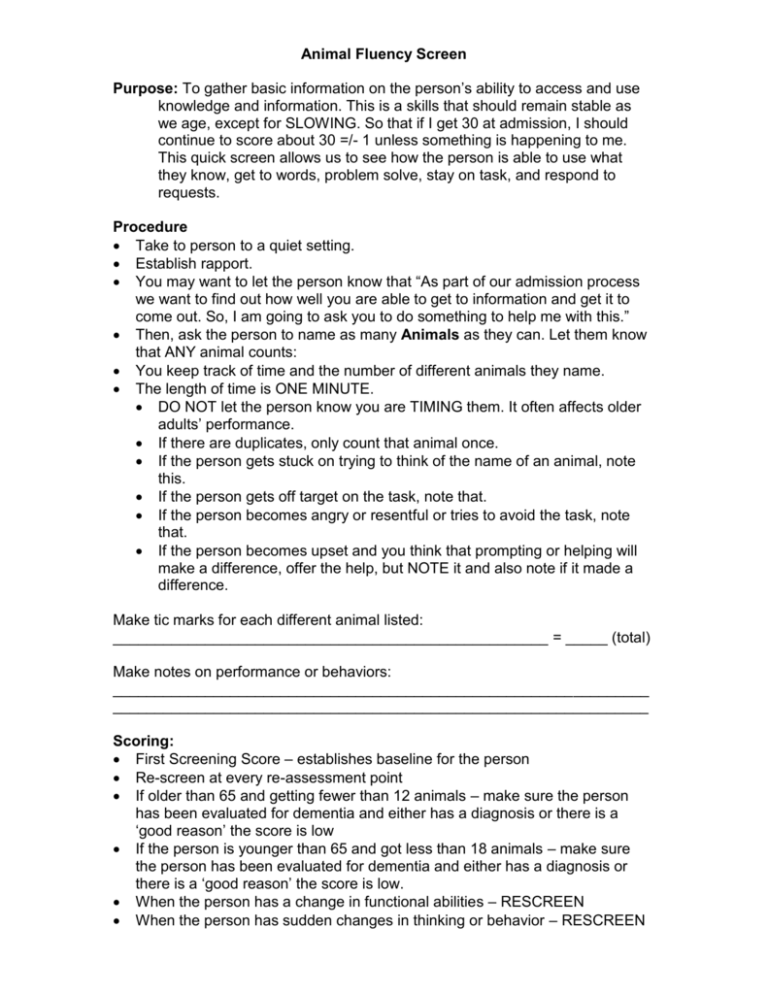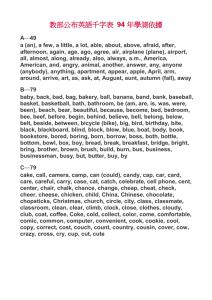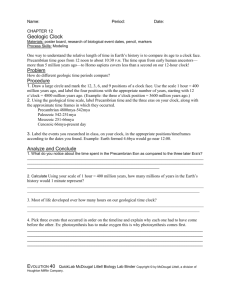List as many Animals as you can think of:
advertisement

Animal Fluency Screen Purpose: To gather basic information on the person’s ability to access and use knowledge and information. This is a skills that should remain stable as we age, except for SLOWING. So that if I get 30 at admission, I should continue to score about 30 =/- 1 unless something is happening to me. This quick screen allows us to see how the person is able to use what they know, get to words, problem solve, stay on task, and respond to requests. Procedure Take to person to a quiet setting. Establish rapport. You may want to let the person know that “As part of our admission process we want to find out how well you are able to get to information and get it to come out. So, I am going to ask you to do something to help me with this.” Then, ask the person to name as many Animals as they can. Let them know that ANY animal counts: You keep track of time and the number of different animals they name. The length of time is ONE MINUTE. DO NOT let the person know you are TIMING them. It often affects older adults’ performance. If there are duplicates, only count that animal once. If the person gets stuck on trying to think of the name of an animal, note this. If the person gets off target on the task, note that. If the person becomes angry or resentful or tries to avoid the task, note that. If the person becomes upset and you think that prompting or helping will make a difference, offer the help, but NOTE it and also note if it made a difference. Make tic marks for each different animal listed: ____________________________________________________ = _____ (total) Make notes on performance or behaviors: ________________________________________________________________ ________________________________________________________________ Scoring: First Screening Score – establishes baseline for the person Re-screen at every re-assessment point If older than 65 and getting fewer than 12 animals – make sure the person has been evaluated for dementia and either has a diagnosis or there is a ‘good reason’ the score is low If the person is younger than 65 and got less than 18 animals – make sure the person has been evaluated for dementia and either has a diagnosis or there is a ‘good reason’ the score is low. When the person has a change in functional abilities – RESCREEN When the person has sudden changes in thinking or behavior – RESCREEN Clock Drawing Screen Purpose: This screen allows us to look at several skills. The ability to follow simple motor commands. The ability to remember and use old knowledge and skills. The ability to use visual-motor skills to complete two different tasks The ability to use visual-spatial skills The ability to hold onto a small piece of information for a short period of time to complete a ‘familiar’ task Decision making and problem-solving skills Procedure: This is a two-part screen 1. Hand the person the paper with the large circle on it. 2. Hand them a pen and ask them to put numbers in the circle to represent the face of a clock. “Put numbers on the face of this clock, please.” 3. NOTE: how they go about doing this task. Look for number placement as well as spacing and sequencing and strategies used 4. Then ask the person to put numbers on the clock to give the time as 2:45 or another time that involves multiple quadrants and is not an :00 time. 5. NOTE: how they progress and accuracy of hand placement and ability to complete the entire task, as well as errors or hesitations. Scoring: Option 1 Score Description of clock 0 Correct time with normal spacing. 1 Slight impairment in spacing of lines or numbers. 2 Noticeable impairment in line spacing. 3 Incorrect spacing between numbers with subsequent inappropriate denotation of time. 4 Obvious errors in time denotation (arms misplaced, numbers in wrong place) 5 Abnormal clock-face drawing with inaccurate time denotation (eg. reversal of numbers, perseveration beyond twelve, misplaced numbers, drawing only to one side, omitting most numbers) 6 Abnormal clock face drawing with inaccurate time denotation (eg reversal of numbers, perseveration beyond twelve, misplaced numbers and drawing to one side and omitting most numbers). 7 A recognizable attempt to draw a clock face but no clear denotation of time. 8 Some evidence that a clock face is drawn. 9 Minimal evidence that a clock face is drawn. 10 No reasonable attempt to drawing a clock face (exclude gross visual disturbance, hemiplegia and severe psychotic state). Option 2 1 point for all the numbers being in the correct order 1 point for the numbers being in the proper special order 1 point for the two hands of the clock 1 point for the correct time. A normal score is four points.








